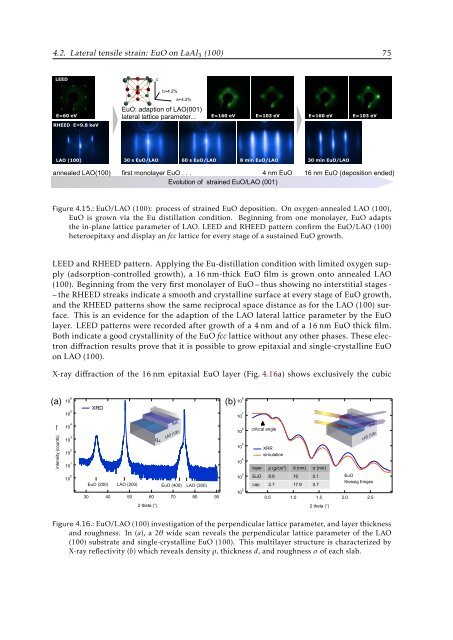Text anzeigen (PDF) - Universität Duisburg-Essen
Text anzeigen (PDF) - Universität Duisburg-Essen
Text anzeigen (PDF) - Universität Duisburg-Essen
Create successful ePaper yourself
Turn your PDF publications into a flip-book with our unique Google optimized e-Paper software.
4.2. Lateral tensile strain: EuO on LaAl 3 (100) 75<br />
LEED<br />
E=60 eV<br />
RHEED E=9.8 keV<br />
c<br />
b+4.2%<br />
a+4.2%<br />
EuO: adaption of LAO(001)<br />
lateral lattice parameter...<br />
E=160 eV E=103 eV E=160 eV E=103 eV<br />
LAO (100) 30 s EuO/LAO 60 s EuO/LAO 8 min EuO/LAO<br />
30 min EuO/LAO<br />
annealed LAO(100) first monolayer EuO . . . 4 nm EuO 16 nm EuO (deposition ended)<br />
Evolution of strained EuO/LAO (001)<br />
Figure 4.15.: EuO/LAO (100): process of strained EuO deposition. On oxygen-annealed LAO (100),<br />
EuO is grown via the Eu distillation condition. Beginning from one monolayer, EuO adapts<br />
the in-plane lattice parameter of LAO. LEED and RHEED pattern confirm the EuO/LAO (100)<br />
heteroepitaxy and display an fcc lattice for every stage of a sustained EuO growth.<br />
LEED and RHEED pattern. Applying the Eu-distillation condition with limited oxygen supply<br />
(adsorption-controlled growth), a 16 nm-thick EuO film is grown onto annealed LAO<br />
(100). Beginning from the very first monolayer of EuO – thus showing no interstitial stages -<br />
– the RHEED streaks indicate a smooth and crystalline surface at every stage of EuO growth,<br />
and the RHEED patterns show the same reciprocal space distance as for the LAO (100) surface.<br />
This is an evidence for the adaption of the LAO lateral lattice parameter by the EuO<br />
layer. LEED patterns were recorded after growth of a 4 nm and of a 16 nm EuO thick film.<br />
Both indicate a good crystallinity of the EuO fcc lattice without any other phases. These electron<br />
diffraction results prove that it is possible to grow epitaxial and single-crystalline EuO<br />
on LAO (100).<br />
X-ray diffraction of the 16 nm epitaxial EuO layer (Fig. 4.16a) shows exclusively the cubic<br />
(a)<br />
intensity (counts) →<br />
10 6 XRD<br />
10 5<br />
10 4<br />
10 3<br />
q ┴<br />
10 2<br />
10 1<br />
10 0<br />
EuO (200) LAO (200) EuO (400) LAO (300)<br />
30 40 50 60 70 80 90<br />
2 theta (°)<br />
(b)<br />
10 7<br />
10 6 critical angle<br />
10 5<br />
XRR<br />
simulation<br />
10 4<br />
layer ρ (g/cm 3 ) d (nm) σ (nm)<br />
10 3 EuO 8.8 16 0.1<br />
EuO<br />
cap 2.7 17.9 0.7<br />
Kiessig fringes<br />
10 2<br />
0.5 1.0 1.5 2.0 2.5<br />
10 8<br />
2 theta (°)<br />
Figure 4.16.: EuO/LAO (100) investigation of the perpendicular lattice parameter, and layer thickness<br />
and roughness. In (a), a 2θ wide scan reveals the perpendicular lattice parameter of the LAO<br />
(100) substrate and single-crystalline EuO (100). This multilayer structure is characterized by<br />
X-ray reflectivity (b) which reveals density ρ, thickness d, and roughness σ of each slab.
















